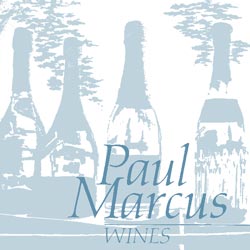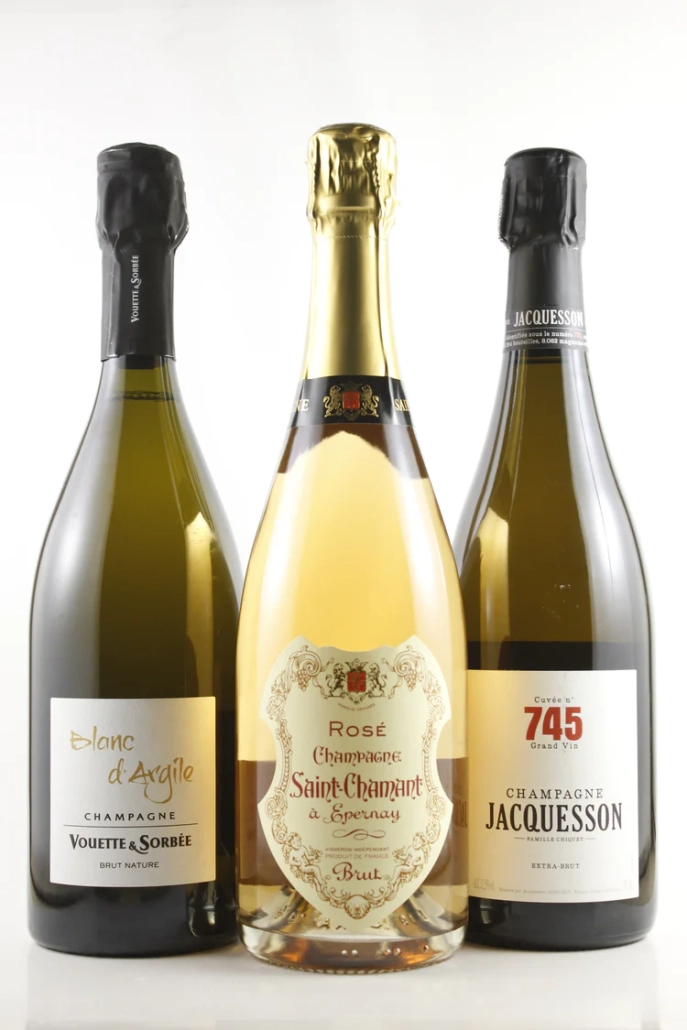Nothing says “holiday celebration” like a bottle or three of Champagne. If you’re looking for some direction in your choice of bubbles, we’ve assembled a three-bottle Champagne Party Pack that showcases the stylistic diversity of the famed region–with different grape blends, dryness levels, vineyard locations, and winemaking approaches. This specially discounted package will help distinguish your own holiday party–and it’s also the perfect gift for the oenophile in your life.
Bottle 1: Vouette & Sorbée Blanc d’Argile Brut Nature ($126)
(Certified Organic, Biodynamic, and Demeter)
This house is named for Bertrand Gautherot’s two growing parcels in the hills of the town of Troyes in the Côte des Bar. Bertrand is a true vigneron–just as present in the fields, cultivating the vines, as he is in the cellar–the epitome of “grower champagne.” His devotion to his vines and to biodynamic viticulture has garnered him quite the cult following. His precision and unwavering attention to quality has made Bertrand a sought-after name among sommeliers and collectors alike.
Bertrand’s wines are all fermented with indigenous yeast in French oak barrels. He prefers to make wines as transparent as possible; therefore, in addition to his strict farming and winemaking practices, he does not add any liqueur de l’expedition (a mix of wine and sugar to top off the bottle after disgorgement). It’s a true brut nature (absolutely no dosage/sugar additions), and he only adds small amounts of sulfur in accordance with the Demeter law.
Bertrand’s vineyards in the Côte des Bar are more akin to those of Chablis: rocky Kimmeridgian and Portlandian limestone. This region of Champagne is known for its pinot noir production, but of course–being the renegade he is–Bertrand’s Blanc d’Argile is 100 percent chardonnay from Briaunes, his largest parcel, with a small amount of fruit from scattered plantings in his other Côte des Bar townships. Its ripe fruit is offset with acidic tension.
Mineral, nougaty, and salty, this wine is often compared to a (bubbly) grand cru Chablis. Pop these bubbles to impress the wine expert in your life or to experience an indulgent night in.
Bottle 2: Saint-Chamant Epernay Rosé Brut ($80)
(Practicing Organic)
Champagne Saint-Chamant was established in 1930 by Pierre and Hélène Coquillette. Their son Christian took over the estate in 1950 and brought Saint-Chamant to international recognition. Christian’s son Stéphane succeeds him as the third generation.
The estate is located in Epernay in the Côte des Blancs, which is known for its chardonnay production. This rosé is 92 percent chardonnay (all grand cru fruit) and 8 percent pinot meunier. Farming is done under organic practices (however, the estate does not hold any certifications). All vineyard work is done by hand. Christian believed in extended lees aging, and all the wines are disgorged to order, something that is particularly unique in Champagne.
This Champagne is rich, with bursts of raspberries and cream upon opening. The finish is dry, with a dosage of only 5g/L, yet creamy. The bubbles are fine, giving this NV Champagne an aged feel. These bubbles are sure to please Champagne drinkers of all types. Enjoy with cheeses, meats, and rich shellfish dishes.
Bottle 3: NV Jacquesson Cuvée 745 Extra Brut ($89)
(Sustainable/Herbicide-Free)
Jacquesson Champagne production traces its roots back to 1798. This name has laid the foundation for some of the greatest and most renowned Champagne houses, such as Krug. (Johann-Joseph Krug left Jacquesson in 1843 to produce his own wine.) The success of Jacquesson, however, is not simply in their longstanding name or parentage of other great houses, but also in their modern manifestation as a large-production, grower Champagne.
In the 1980s, brothers Laurent and Jean-Hervé Chiquet took over the winemaking and estate management from their father. They immediately adopted pesticide-free, organic practices in order to produce a less manipulated, more terroir-driven Champagne style. Only juice from the first pressing is used, and all the juice is either from grand cru or premier cru vineyards. The wine ferments in large foudres with regular battonage (lees stirring).
To further highlight their vines’ terroir, they began using a majority of a single-vintage base for their blended, non-vintage wines–a non-vintage wine in a vintage style. They marked the start of this new philosophy by labeling the wines as the 700 series. They began with 728, and each year, a subsequently numbered cuvée is released, with Cuvée No. 733 based on the 2005 vintage, Cuvée No. 734 based on the 2006 vintage, and so on.
The 745 uses the 2017 harvest as its base and includes grapes from the areas of Ay, Dizy, Hautvillers, Avize, and Oiry (Vallée de la Marne). The blend is always about 80 percent chardonnay plus about 20 percent pinot noir and pinot meunier. Late-onset frosts were particularly destructive and were followed by a hot and wet summer. Rigorous sorting left them with small yields, but incredibly premium fruit.
The wine is lush and plush with a creamier-than-usual palate due to the low, ripe yields. All Jacquesson wines spend a minimum of five years on the lees, and the very low extra-brut dosage of .75g/L deftly complements the wine’s natural ripeness. It offers notes of pineapple and creamy lemon curd, with bright lemony-chalky acidity and persistent perlage (fizziness).
To learn more about these exquisite bottlings or to discover the wide range of Champagne available at Paul Marcus Wines, please visit us at the shop.
— Emilia Aiello


Leave a Reply
Want to join the discussion?Feel free to contribute!